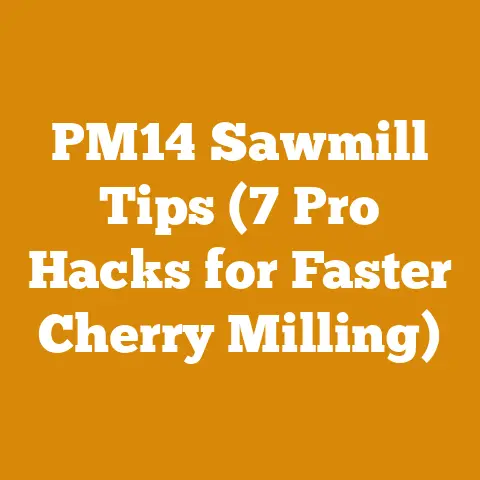Oil for Wood Splitter Maintenance (5 Expert Tips You Must Know)
As someone who’s spent countless hours around wood splitters, I know firsthand how crucial proper maintenance is.
A well-maintained wood splitter isn’t just about convenience; it’s about safety, efficiency, and longevity.
Hydraulic oil is the lifeblood of your wood splitter, and choosing the right oil and maintaining it correctly can dramatically extend the life of your machine.
I’ve seen too many splitters fail prematurely due to neglect, and I’m here to share my experience and guide you through the essential aspects of hydraulic oil maintenance.
Understanding the Vital Role of Hydraulic Oil
Hydraulic oil in a wood splitter is more than just a lubricant.
It’s the power transfer medium, the cooling agent, and the protector against wear and corrosion.
Think of it as the circulatory system of your machine.
Without clean, properly functioning hydraulic oil, your splitter will quickly succumb to inefficiency and eventual failure.
Tip #1: Selecting the Right Hydraulic Oil for Your Wood Splitter
Choosing the right hydraulic oil is the first critical step.
It’s not a one-size-fits-all situation.
Hydraulic Oil Viscosity and Grade
Viscosity is the oil’s resistance to flow.
A thicker oil has higher viscosity.
The right viscosity depends on your operating climate and the manufacturer’s recommendations.
Using the wrong viscosity can lead to sluggish performance, increased wear, or even pump failure.
- ISO Viscosity Grades: Hydraulic oils are classified using ISO (International Organization for Standardization) viscosity grades.
Common grades for wood splitters include ISO 32, ISO 46, and ISO 68. - Temperature Considerations: In colder climates, a lower viscosity oil (like ISO 32) is preferable because it flows more easily at low temperatures.
In warmer climates, a higher viscosity oil (like ISO 46 or ISO 68) is better to maintain proper lubrication at higher temperatures. - Manufacturer Recommendations: Always consult your wood splitter’s manual for the manufacturer’s recommended hydraulic oil viscosity.
This is the most reliable guide.
Types of Hydraulic Oil: Mineral vs. Synthetic
Hydraulic oils come in two main types: mineral-based and synthetic.
Each has its advantages and disadvantages.
- Mineral-Based Hydraulic Oil: This is the most common and affordable type.
It’s suitable for most wood splitting applications, especially in moderate climates and for intermittent use. - Synthetic Hydraulic Oil: Synthetic oils offer superior performance in extreme temperatures and provide better protection against wear and oxidation.
They are more expensive but can extend the life of your splitter, especially in demanding conditions or frequent use. - Biodegradable Hydraulic Oil: If you’re concerned about environmental impact, consider biodegradable hydraulic oil.
These oils are typically vegetable-based and break down more readily than mineral or synthetic oils.
However, they may require more frequent changes.
Additives in Hydraulic Oil
Hydraulic oils contain additives that enhance their performance and protect your equipment.
Common additives include:
- Anti-Wear Additives: These reduce friction and wear between moving parts.
- Anti-Oxidant Additives: These prevent the oil from breaking down due to oxidation, extending its lifespan.
- Anti-Foam Additives: These prevent the formation of foam, which can reduce the oil’s lubricating properties.
- Rust and Corrosion Inhibitors: These protect metal components from rust and corrosion.
My Personal Experience
I once used a generic hydraulic oil that didn’t meet the manufacturer’s specifications.
The splitter worked, but it was noticeably slower, and the pump made a whining noise.
After switching to the recommended synthetic oil, the performance improved dramatically, and the noise disappeared.
This experience taught me the importance of using the right oil.
Actionable Steps:
- Consult your wood splitter’s manual for the recommended hydraulic oil viscosity and type.
- Consider your operating climate and usage frequency when choosing between mineral and synthetic oil.
- Look for hydraulic oils with appropriate additives for wear protection, oxidation resistance, and rust prevention.
Tip #2: Checking and Maintaining Hydraulic Oil Levels
Maintaining the correct hydraulic oil level is crucial for optimal performance and preventing damage to your wood splitter.
Low oil levels can lead to pump cavitation (air bubbles forming in the oil), overheating, and reduced splitting force.
Overfilling can cause leaks and pressure buildup.
How to Check the Hydraulic Oil Level
Most wood splitters have a sight glass or dipstick to check the oil level.
- Sight Glass: The sight glass is a transparent window on the hydraulic reservoir.
The oil level should be within the marked range on the glass. - Dipstick: The dipstick is similar to the one used for checking engine oil.
Remove the dipstick, wipe it clean, reinsert it fully, and then remove it again to check the oil level.
The level should be between the “min” and “max” marks.
Frequency of Checking Oil Levels
- New Splitters: Check the oil level before each use for the first few hours of operation, as new systems may have air trapped in the lines that will bleed out, lowering the oil level.
- Regular Use: Check the oil level every 8-10 hours of operation or at least once a week if you use the splitter frequently.
- After Storage: Check the oil level after a period of storage, as some oil may have leaked out.
Adding Hydraulic Oil
If the oil level is low, add the recommended type of hydraulic oil until it reaches the correct level.
- Cleanliness: Ensure the area around the fill port is clean to prevent dirt and debris from entering the hydraulic system.
- Funnel: Use a clean funnel to avoid spills.
- Proper Oil: Only use the type of hydraulic oil recommended by the manufacturer.
- Avoid Overfilling: Add oil gradually and check the level frequently to avoid overfilling.
Identifying and Addressing Leaks
Hydraulic oil leaks can lead to low oil levels and potential damage to the splitter.
Regularly inspect the hydraulic system for leaks.
- Common Leak Points: Check around the hydraulic cylinder, hoses, fittings, and pump.
- Leak Detection: Look for oil stains or puddles.
You can also use a piece of cardboard to check for leaks by placing it under the splitter overnight. - Addressing Leaks: Tighten loose fittings.
Replace damaged hoses or seals.
If the leak persists, consult a qualified technician.
My Experience with Leaks
I once ignored a small leak in my splitter’s hydraulic cylinder, thinking it wasn’t a big deal.
Over time, the leak worsened, and the splitter’s performance declined significantly.
Eventually, I had to replace the entire cylinder, which was a costly repair.
This taught me the importance of addressing leaks promptly.
Actionable Steps:
- Check the hydraulic oil level regularly using the sight glass or dipstick.
- Add the recommended type of hydraulic oil if the level is low.
- Inspect the hydraulic system for leaks and address them promptly.
Tip #3: Changing the Hydraulic Oil and Filter
Changing the hydraulic oil and filter is essential for maintaining the cleanliness and performance of your wood splitter.
Over time, hydraulic oil degrades and becomes contaminated with dirt, metal particles, and moisture.
A clogged filter restricts oil flow and can damage the hydraulic pump.
Frequency of Oil and Filter Changes
The recommended frequency for changing hydraulic oil and the filter varies depending on the manufacturer and the operating conditions.
- Manufacturer Recommendations: Consult your wood splitter’s manual for the recommended oil and filter change intervals.
- General Guidelines: As a general guideline, change the hydraulic oil and filter every 100-200 hours of operation or at least once a year, even if the splitter is not used frequently.
- Severe Conditions: If you operate your splitter in dusty or dirty conditions, or if you notice the oil becoming dark or cloudy, change the oil and filter more frequently.
Step-by-Step Guide to Changing Hydraulic Oil and Filter
- Gather Supplies: You will need the correct type and quantity of hydraulic oil, a new hydraulic filter, a wrench or socket set, a drain pan, and rags.
- Warm Up the Splitter: Run the splitter for a few minutes to warm up the hydraulic oil.
This will make it flow more easily. - Position the Drain Pan: Place the drain pan under the drain plug on the hydraulic reservoir.
- Remove the Drain Plug: Use a wrench or socket to remove the drain plug and allow the old oil to drain completely.
- Remove the Old Filter: Locate the hydraulic filter (usually near the pump) and unscrew it.
Be prepared for some oil to spill out. - Install the New Filter: Lightly lubricate the rubber gasket on the new filter with hydraulic oil.
Screw the new filter onto the filter housing by hand until the gasket makes contact, then tighten it an additional half turn. - Replace the Drain Plug: Clean the drain plug and reinstall it, tightening it securely.
- Fill the Reservoir: Fill the hydraulic reservoir with the correct type and quantity of hydraulic oil.
Check the oil level using the sight glass or dipstick. - Bleed the System: Start the splitter and run it for a few minutes to circulate the new oil and bleed any air from the system.
Check the oil level again and add more oil if needed. - Dispose of the Old Oil Properly: Take the used hydraulic oil to a recycling center or auto parts store for proper disposal.
Choosing the Right Hydraulic Filter
- Manufacturer Specifications: Always use a hydraulic filter that meets the manufacturer’s specifications.
- Filter Micron Rating: The micron rating indicates the size of particles the filter can remove.
A lower micron rating means the filter can remove smaller particles.
Choose a filter with the appropriate micron rating for your wood splitter. - Filter Type: Hydraulic filters come in different types, including spin-on filters and cartridge filters.
Choose the type that is compatible with your splitter.
My Experience with Oil Changes
I once neglected to change the hydraulic oil in my splitter for too long.
The oil became thick and sludgy, and the splitter’s performance suffered.
After finally changing the oil and filter, the splitter ran like new again.
This experience reinforced the importance of regular oil changes.
Actionable Steps:
- Change the hydraulic oil and filter according to the manufacturer’s recommendations or at least once a year.
- Follow the step-by-step guide for changing the oil and filter.
- Use the correct type and quantity of hydraulic oil and a filter that meets the manufacturer’s specifications.
- Dispose of the old oil properly.
Tip #4: Preventing Contamination of Hydraulic Oil
Contamination is a major cause of hydraulic system failure.
Dirt, water, and other contaminants can damage the hydraulic pump, valves, and cylinder.
Preventing contamination is crucial for extending the life of your wood splitter.
Sources of Contamination
- External Contamination: Dirt, dust, and debris can enter the hydraulic system through the fill port, breather cap, or damaged seals.
- Internal Contamination: Metal particles from wear and tear can accumulate in the hydraulic oil.
- Water Contamination: Water can enter the hydraulic system through condensation, leaks, or improper storage.
Preventing Contamination
- Cleanliness: Keep the area around the fill port and breather cap clean.
Use a clean funnel when adding hydraulic oil. - Seals: Inspect seals regularly and replace them if they are damaged or worn.
- Breather Cap: Ensure the breather cap is clean and functioning properly.
The breather cap allows air to enter and exit the hydraulic reservoir, preventing pressure buildup. - Storage: Store your wood splitter in a clean, dry place.
Cover it to protect it from dust and rain. - Filtration: Use a high-quality hydraulic filter to remove contaminants from the oil.
- Regular Oil Changes: Change the hydraulic oil and filter regularly to remove accumulated contaminants.
Identifying Contaminated Oil
- Visual Inspection: Contaminated hydraulic oil may appear dark, cloudy, or milky.
- Smell: Contaminated oil may have a burnt or sour smell.
- Performance: Contaminated oil can cause reduced splitting force, sluggish performance, and unusual noises from the pump.
Dealing with Contaminated Oil
If you suspect your hydraulic oil is contaminated, take the following steps:
- Drain the Oil: Drain the contaminated oil from the hydraulic reservoir.
- Flush the System: Flush the hydraulic system with clean hydraulic oil to remove any remaining contaminants.
- Replace the Filter: Install a new hydraulic filter.
- Refill the Reservoir: Refill the hydraulic reservoir with clean hydraulic oil.
My Experience with Contamination
I once left my wood splitter uncovered during a rainstorm.
Water entered the hydraulic system, causing the oil to become milky and the splitter’s performance to decline.
I had to drain the oil, flush the system, and replace the filter to restore the splitter to its normal operating condition.
This experience taught me the importance of protecting my equipment from the elements.
Actionable Steps:
- Keep the area around the fill port and breather cap clean.
- Inspect seals regularly and replace them if they are damaged.
- Store your wood splitter in a clean, dry place.
- Use a high-quality hydraulic filter and change the oil and filter regularly.
- Inspect the hydraulic oil regularly for signs of contamination.
Tip #5: Monitoring Hydraulic Oil Temperature
Hydraulic oil temperature is a critical factor affecting the performance and lifespan of your wood splitter.
Overheating can cause the oil to break down, leading to reduced lubrication, increased wear, and potential damage to the hydraulic system.
Ideal Hydraulic Oil Temperature Range
The ideal hydraulic oil temperature range is typically between 100°F (38°C) and 140°F (60°C).
Exceeding this range can significantly reduce the oil’s viscosity and lubricating properties.
Causes of Overheating
- Overuse: Continuous operation for extended periods can cause the hydraulic oil to overheat.
- Low Oil Level: Low oil levels can reduce the system’s ability to dissipate heat.
- Clogged Filter: A clogged filter restricts oil flow, causing the pump to work harder and generate more heat.
- High Ambient Temperature: Operating the splitter in hot weather can contribute to overheating.
- Inefficient Pump: A worn or inefficient pump generates more heat than a properly functioning pump.
- Incorrect Oil Viscosity: Using an oil with too high of a viscosity can cause the system to work harder and generate more heat.
Monitoring Hydraulic Oil Temperature
- Infrared Thermometer: Use an infrared thermometer to measure the temperature of the hydraulic reservoir.
Aim the thermometer at the reservoir and record the temperature. - Temperature Gauge: Some wood splitters are equipped with a temperature gauge that displays the hydraulic oil temperature.
- Observe Performance: Pay attention to the splitter’s performance.
If it starts to slow down or make unusual noises, it may be overheating.
Preventing Overheating
- Duty Cycle: Avoid continuous operation for extended periods.
Allow the splitter to cool down periodically. - Maintain Oil Level: Ensure the hydraulic oil level is at the correct level.
- Change Filter Regularly: Change the hydraulic filter regularly to maintain proper oil flow.
- Operate in Shade: If possible, operate the splitter in the shade to reduce the ambient temperature.
- Cooling Fan: Consider using a cooling fan to circulate air around the hydraulic reservoir.
- Proper Ventilation: Ensure the area around the splitter is well-ventilated.
- Use Correct Oil Viscosity: Use the hydraulic oil viscosity recommended by the manufacturer.
- Inspect Pump: Regularly inspect the hydraulic pump for signs of wear or inefficiency.
Addressing Overheating
If you notice your hydraulic oil is overheating, take the following steps:
- Stop Operation: Stop operating the splitter and allow it to cool down.
- Check Oil Level: Check the hydraulic oil level and add oil if needed.
- Check Filter: Check the hydraulic filter and replace it if it is clogged.
- Inspect Pump: Inspect the hydraulic pump for signs of wear or inefficiency.
- Consider Cooling Measures: Consider using a cooling fan or operating the splitter in the shade.
My Experience with Overheating
I once used my wood splitter for several hours on a hot summer day without taking any breaks.
The hydraulic oil overheated, causing the splitter’s performance to decline significantly.
I had to stop operating the splitter and allow it to cool down before I could resume work.
This experience taught me the importance of monitoring hydraulic oil temperature and taking steps to prevent overheating.
Actionable Steps:
- Monitor the hydraulic oil temperature using an infrared thermometer or temperature gauge.
- Avoid continuous operation for extended periods and allow the splitter to cool down periodically.
- Maintain the correct hydraulic oil level and change the filter regularly.
- Operate the splitter in the shade or use a cooling fan to reduce the ambient temperature.
- Inspect the hydraulic pump for signs of wear or inefficiency.
Additional Tips for Wood Splitter Maintenance
Beyond hydraulic oil maintenance, here are some additional tips to keep your wood splitter in top condition:
- Inspect Hoses and Fittings: Regularly inspect hydraulic hoses and fittings for leaks, cracks, or damage.
Replace damaged components promptly. - Lubricate Moving Parts: Lubricate moving parts, such as the cylinder rod and pivot points, with grease or oil to reduce friction and wear.
- Check the Wedge: Inspect the splitting wedge for sharpness and damage.
Sharpen or replace the wedge as needed. - Tighten Bolts and Fasteners: Regularly check and tighten all bolts and fasteners to prevent loosening.
- Clean the Splitter: Keep the splitter clean by removing dirt, debris, and wood chips.
- Store Properly: Store the splitter in a clean, dry place when not in use.
Cover it to protect it from the elements. - Follow Manufacturer’s Recommendations: Always follow the manufacturer’s recommendations for maintenance and operation.
Safety First
Always prioritize safety when operating and maintaining a wood splitter.
- Wear Safety Gear: Wear safety glasses, gloves, and sturdy footwear.
- Read the Manual: Read and understand the owner’s manual before operating the splitter.
- Keep Clear: Keep bystanders and pets away from the splitter while it is in operation.
- Work on a Level Surface: Operate the splitter on a level surface to prevent tipping.
- Never Modify: Never modify the splitter in any way that could compromise its safety.
- Disconnect Power: Disconnect the power source before performing any maintenance.
Conclusion: Investing in Longevity
Maintaining your wood splitter’s hydraulic system with the right oil and consistent care is an investment that pays dividends.
By following these expert tips, you’ll not only extend the life of your machine but also ensure it operates safely and efficiently for years to come.
Remember, a little preventative maintenance goes a long way in avoiding costly repairs and maximizing your wood-splitting productivity.






